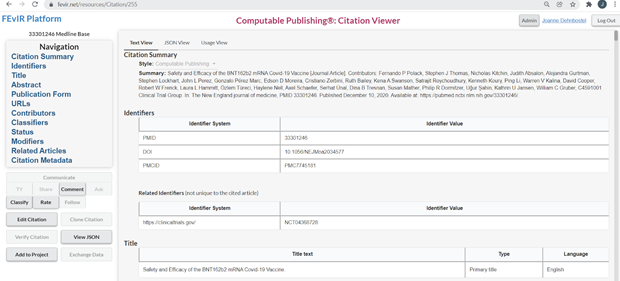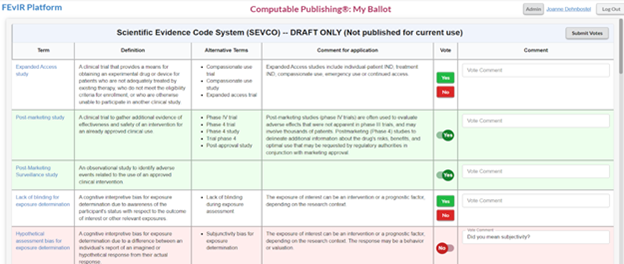.png?width=600&height=200&name=Computable%20Publishing%20Blog%20(600%20%C3%97%20200%20px).png)
Computable Publishing LLC was pleased to sponsor the January 2022 HL7 Working Group Meeting, which aligns with our work towards creating software tools that support data exchange for scientific knowledge with HL7 Fast Healthcare Interoperability Resources (FHIR®). In fact, many already know that our CEO, Brian Alper, is the leader of the Evidence-Based Medicine on the FHIR project (EBMonFHIR) and the COVID-19 Knowledge Accelerator (COKA) initiative.
Background & Expansion
EBMonFHIR (sponsored by the CDS, BR&R and CQI HL7 work groups) previously created Citation, Evidence, EvidenceReport and Evidenceariable Resources. The project expansion to the COKA initiative now involves 12 active working group meetings per week. The combination of volunteer efforts from about 100 people in many countries along with software tools (provided gratis to COKA by Computable Publishing LLC) has produced impressive results to advance evidence-based medicine (EBM) and promote the HL7 FHIR standard to the EBM community.
Tool Development
Computable Publishing LLC has developed about 30 tools to support the creation and viewing of evidence-related data in FHIR Resources. There is one tool that supports all of them: the Fast Evidence Interoperability Resources (FEvIR) Platform (https://fevir.net).
To overcome the challenge of inability to easily reuse registered research data, our organization collaborated with ClinicalTrials.gov. This collaboration resulted in the development of the ClinicalTrials.gov-to-FEvIR Converter, which can be used to transform the ClinicalTrials.gov data into the following FHIR Resources to fully express the entire ClinicalTrials.gov record using FHIR: ResearchStudy, EvidenceReport, Organization, Practitioner, PractitionerRole, Citation, Evidence, EvidenceVariable, and Group.
Another benefit of this tool is that one doesn’t need to be a coding expert to use it. Simply enter the NCT identifier and once that step is complete, the JSON FHIR resources will be ready for reuse. We also made multiple improvements to the FHIR ResearchStudy Resource in this effort.
Computable Publishing LLC also created a similar tool on the FEvIR platform. It is called the MEDLINE-to-FEvIR Converter, and will convert any PubMed citation into a FHIR Citation Resource, with both human-readable and FHIR JSON versions available for use. Enter the PMID and a FHIR Citation is born that can be used interoperably with any app using the FHIR Citation standard.

Image: Citation Viewer
Global Effort = Results
Because we couldn’t find adequate code systems to summarize statistics, study design, and risk of bias concepts, we started a global effort to build our own Scientific Evidence Code System (SEVCO).
So far, with a growing global Expert Working Group, 534 terms have been drafted and 153 (29%) have been fully approved. Tooling was needed to support this effort, so we created a CodeSystem Builder/Viewer as well as a ValueSet Builder/Viewer.
Unique Challenge
With the introduction of a Citation Resource, citation repository developers identified the desire to exchange the “classification tags” related to citations and made the case for making these metadata tags shareable value units. For the “Comment” and “Vote” functions for the SEVCO code system, we needed a way to exchange comments and ratings of a CodeSystem Resource (and specific terms in the resource) without overloading the CodeSystem Resource itself. These multiple use cases for sharing knowledge about knowledge artifacts led us to introduce the ArtifactAssessment Resource, which received high interest from many HL7 work groups.
Adding a “Vote” feature to create ArtifactAssessment Resources greatly accelerated the SEVCO development effort. However, we then had the challenge of hundreds of voter/term/instance combinations. The My Ballot tool allows scaled voting coordinated with the CodeSystem Resource in development. We now have a second group of people using this software to develop a code system for rating certainty of evidence and strength of recommendation and expect to support many projects of this type with FHIR resources.

Image: My Ballot
The risk of bias segment of our code system is being used to support our new Risk of Bias Assessment Tool (RoBAT) as a means to rate bias in scientific articles, e.g. in the context of creating systematic reviews or providing peer review for journal articles. The RoBAT is heavily dependent on CodeSystem, ValueSet and Artifact Assessment FHIR resources.
For the COKA Initiative, 2022 will be the year of usability research. We have launched a Pilot Study for RoBAT with FHIR Resources (ResearchStudy, ResearchSubject, Consent, Questionnaire, QuestionnaireResponse, Group, EvidenceVariable and Evidence) to manage every aspect.
Get Involved
We highly depend on the support of many volunteers through the COVID-19 Knowledge Accelerator and EBMonFHIR groups. Join us to help with any or all of these projects by visiting our website and visit the FEvIR platform https://FEvIR.net to see for yourself.


